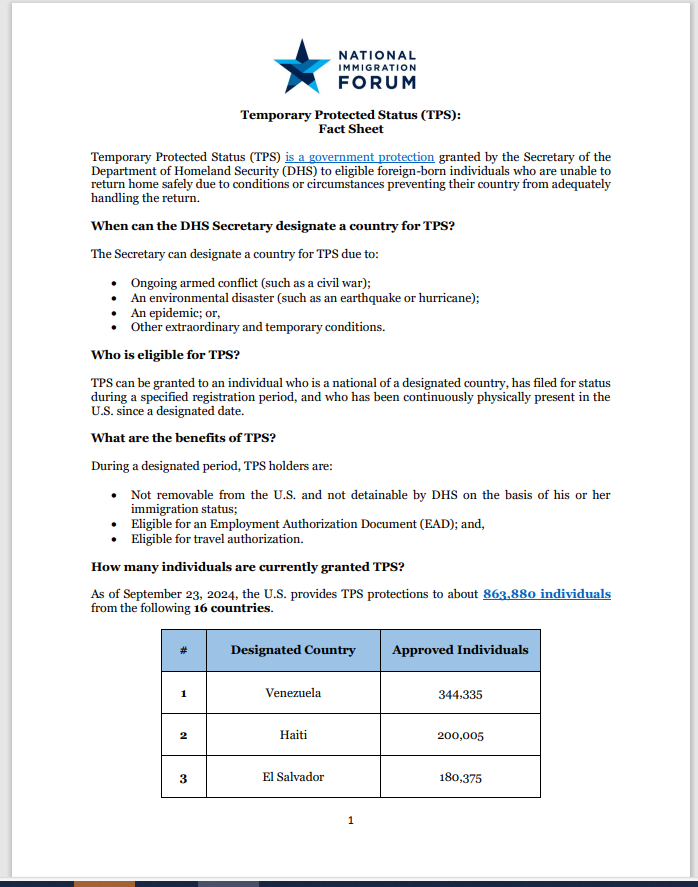
Temporary Protected Status (TPS) is a government protection granted by the Secretary of the Department of Homeland Security (DHS) to eligible foreign-born individuals who are unable to return home safely due to conditions or circumstances preventing their country from adequately handling the return.
When can the DHS Secretary designate a country for TPS?
The Secretary can designate a country for TPS due to:
- Ongoing armed conflict (such as a civil war);
- An environmental disaster (such as an earthquake or hurricane);
- An epidemic; or,
- Other extraordinary and temporary conditions.
Who is eligible for TPS?
TPS can be granted to an individual who is a national of a designated country, has filed for status during a specified registration period, and who has been continuously physically present in the U.S. since a designated date.
What are the benefits of TPS?
During a designated period, TPS holders are:
- Not removable from the U.S. and not detainable by DHS on the basis of his or her immigration status;
- Eligible for an Employment Authorization Document (EAD); and,
- Eligible for travel authorization.
How many individuals are currently granted TPS?
As of September 30, 2024, the U.S. provides TPS protections to about 1,095,115 individuals from the following 16 countries.
Lebanon’s TPS designation was announced on October 17, 2024. There were no approved TPS recipients under this designation as of September 30, 2024.
When do TPS designations expire?
The DHS Secretary can extend TPS after a review of country conditions. A decision concerning an extension must be made at least 60 days before the TPS designation is set to expire. The Secretary can extend the TPS designation for a six, 12 or 18-month period or decide to cancel the designation.
TPS extensions only apply to those who already have TPS status. Foreign nationals who arrive after the designated start date (i.e. “required arrival date”) are only made eligible for status if TPS is newly re-designated for their country.
| Designated Country | Required Arrival Date | Secretary’s Decision Due | Expiration Date | TPS Holders | TPS Eligible |
| Venezuela (2023) | 07/31/2023 | 02/01/2025 | Termination effective on May 19, 2025* (pursuant to U.S. Supreme Court decision) | 248,775 | 472,000 |
| Afghanistan | 09/20/2023 | 03/21/2025 | May 20, 2025 (termination effective on July 14, 2025) | 11,700 (~ May 2025) | 17,700 |
| Cameroon | 10/05/2023 | 04/08/2025 | June 7, 2025 (termination effective on August 4, 2025) | 5,200 (~ June 2025) | 10,000 |
| Nepal | 06/24/2015 | 04/25/2025 | June 24, 2025 (termination effective on August 5, 2025) | 12,700 (~ June 2025) | ~ 14,500 |
| Haiti | 06/03/2025 | 06/04/2025 | August 3, 2025 (termination effective on September 2, 2025) | 348,187 (~ June 2025) | 474,000 |
| Honduras | 12/30/1998 | 05/06/2025 | July 5, 2025 (termination effective on September 8, 2025) | 72,000 (~ July 2025) | ~ 76,000 |
| Nicaragua | 12/30/1998 | 05/06/2025 | July 5, 2025 (termination effective on September 8, 2025) | 4,000 (~ July 2025) | ~ 4,000 |
| Venezuela (2021) | 03/08/2021 | 07/12/2025 | Sept. 10, 2025 | 256,625 | 323,000 |
| Syria | 01/25/2024 | 08/01/2025 | Sept. 30, 2025 | 3,750 | 8,200 |
| South Sudan | 09/02/2023 | 09/03/2025 | Nov. 3, 2025 | 175 (~ 200) | ~ 280 |
| Burma | 03/21/2024 | 09/26/2025 | Nov. 25, 2025 | 3,275 | 7,300 |
| Ethiopia | 04/11/2024 | 10/13/2025 | Dec. 12, 2025 | 3,745 | 12,800 |
| Yemen | 07/02/2024 | 01/02/2026 | March 3, 2026 | 1,975 | 4,000 |
| Somalia | 07/12/2024 | 01/16/2026 | March 17, 2026 | 605 | 4,900 |
| El Salvador | 03/09/2001 | 07/11/2026 | Sept. 9, 2026 | 174,190 | 232,000 |
| Sudan | 03/01/2022 | 08/20/2026 | Oct. 19, 2026 | 1,635 | 3,950 |
| Ukraine | 04/11/2022 | 08/20/2026 | Oct. 19, 2026 | 63,425 | 103,700 |
.
Terminated: Venezuela 2023 TPS Designation
On February 5, 2025, DHS Secretary Kristi Noem decided to terminate TPS protections for Venezuela under the 2023 designation. This move overturned a decision by the Biden administration to extend protections until October 2, 2026. Secretary Noem’s decision ended access to TPS protections for up to 472,000 eligible individuals from Venezuela, including about 250,000 active TPS holders. On March 31, U.S. District Judge Edward Chen in San Francisco temporarily blocked DHS’ attempt to end TPS protections for Venezuelans under the 2023 designation, extending those TPS protections until the Biden administration’s original date of October 2, 2026. The Trump administration appealed the court’s decision. On May 19, the U.S. Supreme Court ruled in a procedural decision that the administration could proceed with ending TPS for Venezuela under the 2023 designation while legal challenges to the decision continue in the lower courts. Following the Supreme Court’s decision, the district court ordered on May 30 that TPS beneficiaries who received an extension of their status on or before February 5 – when DHS announced it would end the 2023 designation – continue to maintain their status pending resolution of the litigation.
*Note: Pursuant to court orders, under the Venezuela 2023 TPS designation, individuals who received TPS-related employment authorization document or Forms I-797 (Notices of Action) with an October 2, 2026 expiration date on or before February 5, 2025 will maintain TPS protections pending resolution of the litigation.
All TPS-related documentation with an expiration date of October 2, 2026 received after February 5, 2025 is no longer valid. All TPS-documentation with an April 3, 2025 expiration date is terminated.
TPS Terminations: Afghanistan, Cameroon, Nepal, Honduras & Nicaragua
DHS announced on April 11, 2025 that it would terminate TPS protections for Afghanistan and Cameroon, making more than 17,000 individuals ineligible to work legally in the U.S. and susceptible to deportation. The effective TPS termination date for Afghanistan is on July 15, 2025, and for Cameroon it is on August 4, 2025.
On June 6, DHS announced that it would terminate TPS protections for Nepal. The effective termination date for Nepal is on August 5, 2025. This move will make about 12,700 individuals ineligible to work legally in the U.S. and susceptible to deportation.
On July 7, DHS announced that it would terminate TPS protections for Honduras and Nicaragua. The effective termination date for both countries is on September 8, 2025. The decision will impact approximately 72,000 TPS holders from Honduras and 4,000 from Nicaragua.
Terminated: Haiti TPS Designation
DHS announced on February 20, 2025 that Secretary Noem decided to amend the period of extension and redesignation of Haiti for TPS from 18 months to 12 months, with a new end date of August 3, 2025. Noem stated that the decision restores TPS to its “original status as temporary” and criticized the extension of Haiti and other countries at the end of the Biden administration as attempts to “tie the hands” of the Trump administration.
On July 1, DHS announced that it would terminate TPS protections for Haiti, with an effective termination date of September 2, 2025. This decision will impact 348,000 TPS holders, making them susceptible to deportation and ineligible to work legally in the U.S.
What will happen to TPS holders whose countries’ designations were terminated?
Once TPS protection ends, a TPS holder will revert back to his or her previous immigration status. For those without legal status in the U.S., they will return to an undocumented status and potentially be subject to removal proceedings.
President Trump attempted to end TPS designations in his first administration for several countries, including El Salvador, Honduras, Nepal, Nicaragua, and Sudan. These decisions faced legal challenges. While the court cases were ongoing, federal courts generally permitted TPS holders to maintain their protections. On September 14, 2020, the U.S. Court of Appeals for the Ninth Circuit allowed the termination of TPS for El Salvador, Nicaragua, and Sudan to proceed. That decision was appealed and, once the Biden administration came into office in early 2021, settlement talks were initiated. On June 13, 2023, the Biden administration announced it was rescinding the Trump-era terminations.
Where do TPS holders live?
TPS holders reside all over the United States. As of September 30, 2024, the largest populations of TPS holders live in Florida (357,895), Texas (124,710), New York (86,665), California (72,585), New Jersey (39,010), and Georgia (41,325).
| TPS Holders by State of Residence | |||||
| # | State | TPS Holders | # | State | TPS Holders |
| 1 | Florida | 357,895 | 27 | Alabama | 4,060 |
| 2 | Texas | 124,710 | 28 | Oregon | 3,985 |
| 3 | New York | 86,665 | 29 | Delaware | 3,950 |
| 4 | California | 72,585 | 30 | Missouri | 3,880 |
| 5 | Georgia | 41,325 | 31 | Wisconsin | 3,870 |
| 6 | New Jersey | 39,020 | 32 | Louisiana | 3,460 |
| 7 | Massachusetts | 35,320 | 33 | Washington, D.C. | 3,250 |
| 8 | Illinois | 32,630 | 34 | Arkansas | 3,190 |
| 9 | Maryland | 30,930 | 35 | Iowa | 2,0950 |
| 10 | Virginia | 28,225 | 36 | Kansas | 2,880 |
| 11 | North Carolina | 27,065 | 37 | Nebraska | 2,300 |
| 12 | Indiana | 26,555 | 38 | Rhode Island | 1,820 |
| 13 | Ohio | 19,070 | 39 | Mississippi | 880 |
| 14 | Pennsylvania | 17,060 | 40 | New Mexico | 800 |
| 15 | Tennessee | 15,940 | 41 | Idaho | 760 |
| 16 | Utah | 15,765 | 42 | New Hampshire | 710 |
| 17 | Washington | 12,785 | 43 | North Dakota | 585 |
| 18 | Colorado | 11,900 | 44 | Maine | 565 |
| 19 | South Carolina | 8,310 | 45 | South Dakota | 495 |
| 20 | Connecticut | 7,660 | 46 | West Virginia | 425 |
| 21 | Minnesota | 6,625 | 47 | Alaska | 375 |
| 22 | Michigan | 5,940 | 48 | Hawaii | 295 |
| 23 | Nevada | 5,185 | 49 | Montana | 285 |
| 24 | Arizona | 5,015 | 50 | Wyoming | 160 |
| 25 | Kentucky | 4,620 | 51 | Vermont | 145 |
| 26 | Oklahoma | 4,415 | # | Other/Unknown | 2,330 |
.
How do TPS holders contribute to our economy?
TPS holders from El Salvador, Honduras, and Haiti contribute a combined $4.5 billion in pre-tax wages or salary income annually, as of April 2017. The total Social Security and Medicare contributions of those individuals is estimated at more than $6.9 billion over a ten-year span.
An estimated 130,000 TPS holders work as “essential critical infrastructure workers,” with more than 94 percent of TPS holders in the labor force as of 2017.
.
Updated July 10, 2025
.


